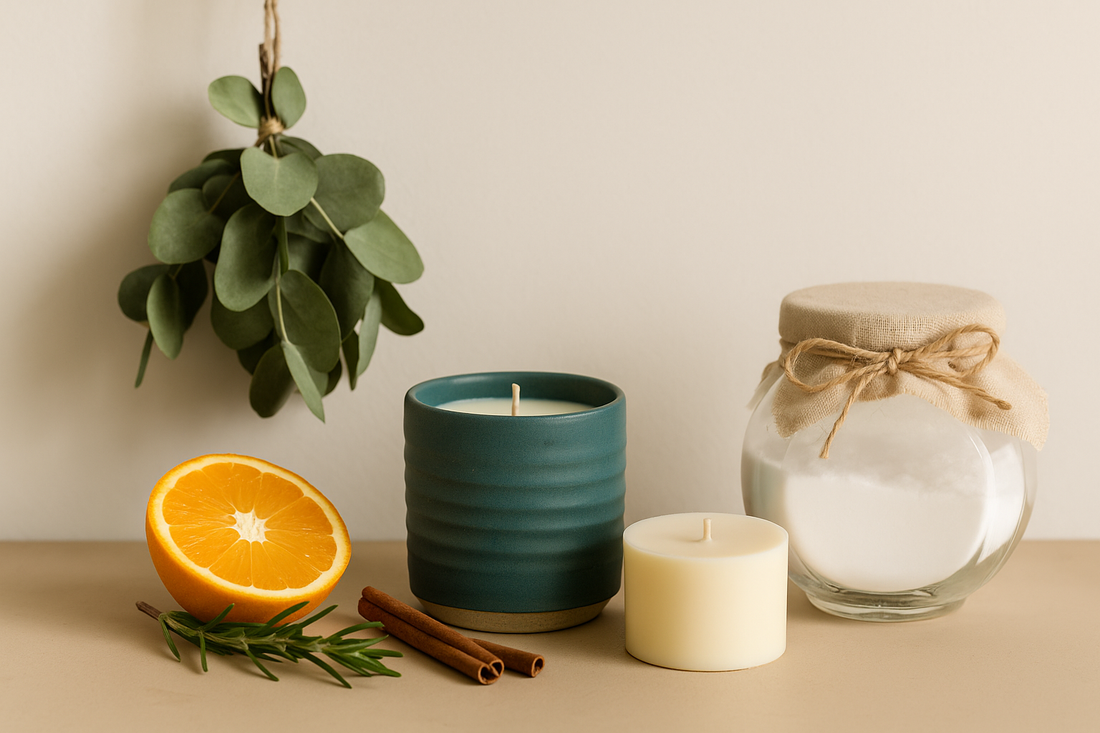Creating a beautifully scented home doesn’t have to come with synthetic sprays, disposable plug-ins, or heaps of packaging. In fact, some of the most satisfying ways to fragrance your space are also the most sustainable.
Here’s how to scent your home the low-waste way — using everyday materials, smart habits, and tools like refillable candles that support your sustainability goals.
1. Eliminate Odor at the Source
Before you add scent, clear the air. Literally.
Most store-bought air fresheners don’t actually clean anything — they just mask odor with overpowering fragrance. A zero waste approach starts with freshness as the baseline.
Here’s how:
- Open windows often. Even five minutes a day helps reset air quality.
- Clean out trash bins weekly. Sprinkle in baking soda and drop in a few citrus peels to absorb odors naturally.
- Scrub kitchen drains and disposal units. Hot water + vinegar + baking soda = magic.
- Switch to plant-based cleaners. They leave behind less chemical residue — which means your home smells like your home, not a lab.
Once your air is clean, you’re ready to add scent intentionally — not to cover, but to elevate.
2. Natural, Low-Waste Aroma Hacks
Skip the synthetic room sprays. Your pantry already has everything you need.
- Simmer pots: Add citrus peels, cinnamon sticks, cloves, or rosemary to a pot of water and let it gently simmer. It’s an incredible way to repurpose food scraps while filling your home with warmth.
- Baking soda jars: Fill a small jar with baking soda and a few drops of essential oil (like lavender or eucalyptus). Cover with breathable fabric and place it near sinks or closets.
- Shower eucalyptus: Hang a bundle from your shower head. The steam will release the plant’s naturally invigorating scent.
- Citrus vinegar spray: Infuse vinegar with leftover citrus peels for two weeks, then dilute with water for a natural room spray.
Each of these options is low-impact, compostable, and budget-friendly — a win all around.
3. Living Scents: Plants & Herbs
Some of the best home fragrances are the ones that grow.
Houseplants and herbs pull double duty — they purify the air and gently scent your space.
Try these zero waste favorites:
- Lavender: Dried or fresh, this herb brings calm and light floral notes.
- Mint or basil: Fresh and clean, ideal for kitchens and entryways.
- Rosemary or thyme: Earthy and grounding, great for mixing with citrus.
- Air-purifying plants: Snake plant, dracaena, and pothos help filter toxins and support better air flow.
No packaging, no harsh chemicals — just nature doing its thing.
4. Fragrance Tools That Support Zero Waste
Here’s where you can make the biggest impact: how you scent your home.
Opt for reusable, long-lasting tools that align with a low-waste mindset:
Use a refillable candle. Ours are made with clean-burning soy wax and non-toxic fragrance, designed to pop in and out of a handmade ceramic candle vessel — no scraping or cleaning required.
Skip single-use plug-ins or synthetic diffusers. Look for reusable reed diffusers you can refill with essential oils.
Try a candle subscription. Regular deliveries of zero waste candle refills mean you never run out — and you avoid impulse buys at the drugstore.
These small switches are part of a bigger habit shift — from disposable to intentional.
5. Ritualizing Scent Sustainably
Your home’s scent doesn’t need to hit you all at once. In fact, subtlety is part of the magic — and a slower, seasonal rhythm is better for your health, wallet, and the planet.
Try this:
- Burn candles thoughtfully. Keep the wick trimmed to ¼ inch, and burn for no more than 3–4 hours at a time.
- Swap scents with the season. Warmer notes in winter (Amber Noir, Mediterranean Fig), fresh and bright in spring (Blood Orange, White Eucalyptus).
- Reuse your vessel. Once the wax burns down, let the jar cool and simply drop in your next wax refill. No heating, no waste.
- Compost when possible. Herbs, peels, and even used baking soda from odor jars can be added to your compost bin.
These rituals make your home feel more alive — and more aligned with what matters to you.
FAQ: Common Questions About Zero Waste Scenting
How long do baking soda odor jars last?
About 30 days — stir weekly and replace monthly.
Can I use essential oils around pets?
Some oils (like tea tree or citrus) can be irritating to pets. Use diluted oils sparingly and avoid direct contact with fur, paws, or bedding.
Are simmer pots safe every day?
Yes, as long as you keep an eye on the water level. Never leave them unattended.
How do I layer scents naturally?
Try one strong base (like a candle) and one subtle accent (like fresh herbs or a diffuser). Stick to the same fragrance family — floral, citrus, herbal, woodsy.
Bring It All Together: A Zero Waste Fragrance Routine
Here’s a simple weekly rhythm to help you make scent part of your sustainable lifestyle:
Mondays: Open windows, fresh air sweep
Tuesdays: Simmer pot with citrus peels and cloves
Wednesdays: Refresh baking soda jars
Thursdays: Trim candle wick, burn Lavender for evening calm
Fridays: Compost food scraps, prep herb bundles
Saturdays: Rotate scents with a new soy wax refill
Sundays: Rest, light a candle, and enjoy the clean slate With a few simple swaps and habits, zero waste scenting can become less of a “project” and more of a pleasure — and ReCandle is here to make that transition feel as seamless (and beautiful) as possible.
